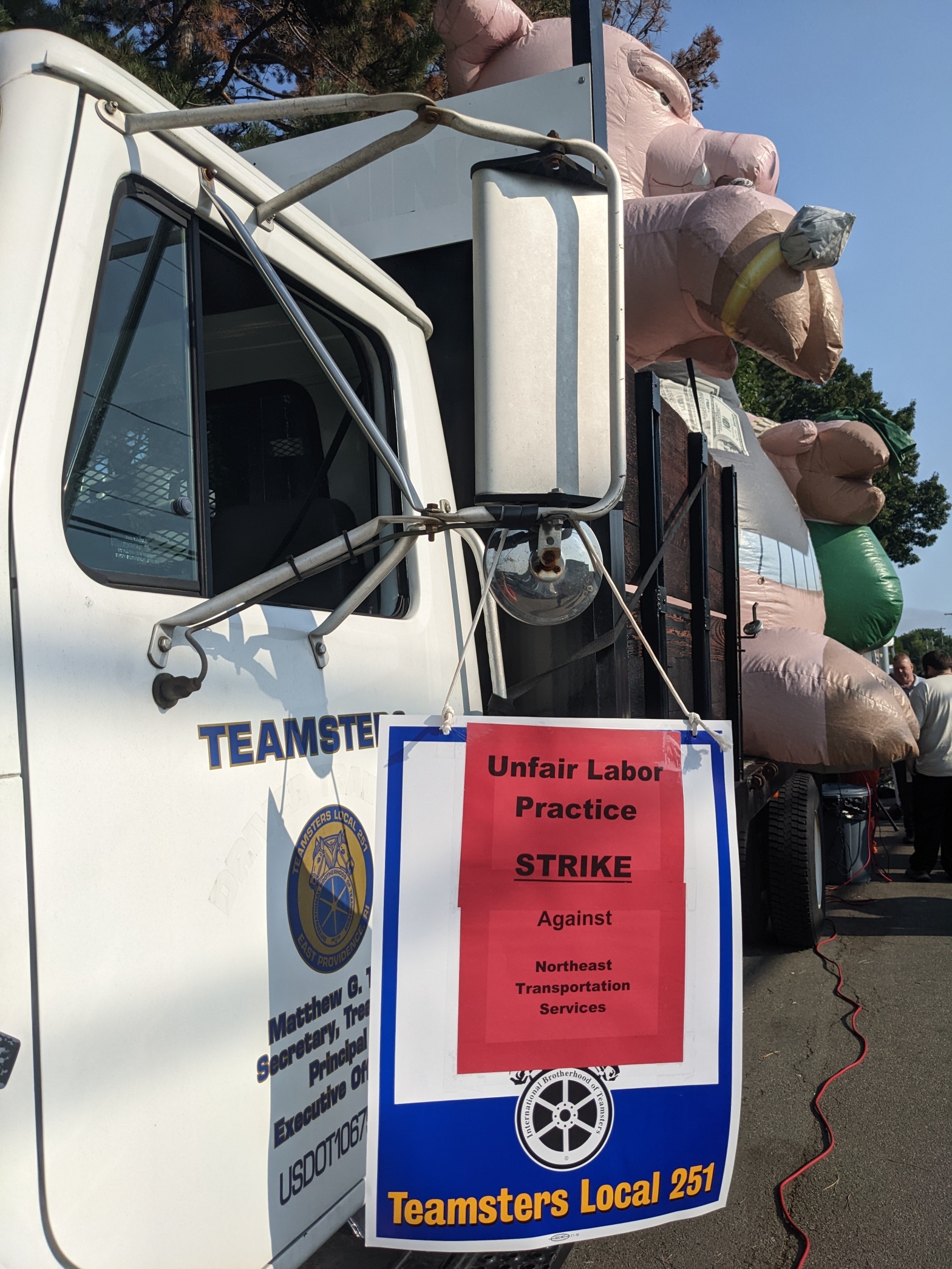by Claire Bayler and Elisabeth Wichser
A Gallup poll in early September recorded a 71% approval rating for unions, the highest since 1965. Large corporations previously untouched by unions are now facing organizing drives. The successful union elections at 245 Starbucks locations nationwide are one highly visible example of union success this year. Workers with established unions, like the Teamsters, are also moving into action.
After decades of low wages and with the highest inflation rates in 40 years, workers see unions as a way to help afford basic necessities. However, more has to be done to turn growing support for unions into militant action by the labor movement for better jobs, benefits, and living standards.
Starbucks
Starbucks workers are organizing as part of Starbucks Workers United (SBWU), but the corporation still refuses to negotiate contracts. For the most part, the National Labor Relations Board (NLRB) has ignored the 634 cases of Starbucks violating labor law, issuing only 26 complaints against Starbucks corporation.
Since the start of the union drive, Starbucks has threatened to close at least 16 shops over “safety concerns.” Although only 3% of Starbucks stores are unionizing, more than 30% of the stores closing are union shops. So far, only workers in Seattle have negotiated an agreement to stay employed at Starbucks as their stores close. Dozens of locations have struck in recent months to demand contracts. Winning good first contracts will take mass coordinated strike action (visit our website for further coverage).
Railroads
Twelve rail unions, representing over 100,000 workers, have bargained together for the last three years against the major railroad companies.
Rail corporations are aggressively increasing their profits by slashing jobs and understaffing workplaces, severely disrupting service and creating dangerous conditions for workers and communities. Since November 2018, corporations have cut 40,000 railroad jobs–over 20% of rail jobs nationwide. Meanwhile, CSX’s profits reached $3.939 billion, up 16% from 2021.
Surviving rail jobs are increasingly unworkable. Inhumane attendance policies keep engineers and conductors working or “on call” 90 percent of the time. Railroaders have as little as one paid sick day a year and face severe penalties for calling in sick or taking time off, including for family deaths. These attendance policies are more than just cruel—they are deadly.
The risk of a fatality per 100,000 miles has increased 60% since 2017, with a 9.4% increase in accidents. Workers have died from shifts interfering with medical care. In this contract, union members are willing to fight, especially for paid time off and better working conditions.
Many railroad workers support striking for a good contract, including members of the Brotherhood of Locomotive Engineers, who overwhelmingly voted to authorize a strike in late August/Early September.
Hours before the strike deadline, President Biden and Labor Secretary Marty Walsh intervened on behalf of the rail corporations. Union leaders called off the strike, claiming a “tentative agreement” (TA) was reached but with nothing more than verbal assurances on major sticking points.
While the union bureaucrats attempted to cut across the pro-strike momentum, many workers are still angry about the weak, tentative agreement. The TA offers only one more paid day off and wage increases that are almost entirely offset by higher healthcare costs and cost of living increases. Since the print publication of this article, International Association of Machinists (IAM) District 19, the Brotherhood of Railroad Signalmen (BLS) and the Brotherhood of Maintenance of Way Employees (BMWE) have all rejected the tentative agreement in their ratification votes.
Railroad Workers United, an “inter-union solidarity caucus,” received over 3,000 responses from union rail workers to their survey about the Presidential Emergency Board (PEB) recommendations. In the poll, 93% of workers stated they would vote against the PEB recommendations, and 95% favored striking. A rail strike could shut down 15% of the economy.
A train conductor member of the Independent Socialist Group told Socialism Today: “I’m planning on voting no on the tentative agreement. The pay increases don’t keep up with the massive profits the companies have made on our backs. Our healthcare premiums are increasing. The provisions for additional time off and sick time are an insult and totally inadequate to address the quality of life of railroaders. In addition, the contract allows the carriers to erode what little scheduling protections road crews have and has no provisions for safe minimum staffing levels across all the various crafts.”
Rail workers could still strike. The union bureaucracy has already given away one major opportunity for a powerful strike, but the anger among rank-and-file members may yet, if organized, push the leadership to action.
Amazon
At Amazon, the Amazon Labor Union (ALU) has not had a series of wins comparable to the Starbucks unionization campaign. ALU successfully defeated a legal challenge by Amazon, which would have reversed the first ALU victory at the Staten Island “JFK8” warehouse. ALU announced organizing drives at a handful of other locations, and another wave of walkouts hit several Amazon locations.
In May, the ALU lost a union election in Brooklyn due to union-busting efforts. Such defeats could threaten the momentum of the organizing campaigns. A union election at the Amazon “ALB1” facility in Schodack, NY, near Albany, begins October 12. Like the SBWU, ALU has not yet forced Amazon into negotiations for a first contract.
Organizing Amazon is a key battle, not just for ALU but unions in general. ALU is taking on the largest corporation in the world. The union will need much more support from workers and other unions organizing mass protests, coordinating solidarity strikes, sharing resources, and joining together in a united front against the big corporations to win contracts.
What the Unions Need in Order to Win
Unions can win important, far-reaching demands but only with leaders who have anti-corporate and anti-capitalist ideas and strategies and are ready to organize union members to fight big business.
There’s been a long decline from the peak of union density in the early 1950s when 35% of U.S. workers were in unions. Unions have been severely weakened by corporate and government union-busting attacks and pro-business union bureaucrats who see themselves as “partners” with management.
Many workers instinctively turn to unions as a way to improve their lives. But they can become disillusioned by labor leaders conceding and collaborating with the bosses when workers are ready to fight. The solution is not to abandon unions but to reclaim them.
The labor movement’s potential will only be fulfilled if we replace the labor bureaucracy with democratically-elected accountable leaders who face the same living conditions as workers and are subject to recall. Union democracy is essential to ensuring that workers are not forced to accept bad contracts or bargain away the right to strike.
That fight for union democracy must extend to what unions support politically. Every year, millions of dollars of members’ union dues are wasted on backing electoral campaigns of the two corporate parties (usually the Democrats).
Over the last three years, many rail union leaders claimed a good contract could only be negotiated under a Democratic administration. But the rail union leaders caved to pressure from the Biden Administration, whose Presidential Emergency Board recommendations gave the corporations almost everything they wanted in negotiations.
Now, union leaders tell rail workers that “we can’t strike” because it puts the Democrats at risk in the midterms. Labor leaders put corporate politics above members’ interests and failed the unions’ powerful position in the logistics network to put economic pressure on the corporations for a fair contract.
Unions cannot forfeit political struggle. The fight for living wages, better benefits, and good working conditions at Starbucks, Amazon, and other workplaces is blocked on the political front through bodies like the National Labor Relations Board and the Supreme Court, which are most often influenced by corporations and the government against union organizing.
Workers and unions must fight against laws that hurt the labor movement, fight for laws that protect our rights and build a new political party to help organize that political struggle. The West Virginia Teacher’s strike in 2018 won major gains because rank-and-file members went on strike despite restrictions placed by labor laws and union bureaucrats. That victory inspired teachers to strike across the country.
While many workers look towards unions as a way to fight back, the current wave of union interest and activity might not last. High-profile defeats in union elections or strikes, government attacks, or job losses due to a recession could deflate current momentum.
For unions to organize the tens of millions of workers needed to rebuild the labor movement and win real gains, unions have to become known for aggressively fighting for the entire working class. Demands like a minimum wage of at least $20 an hour indexed to the cost of living, a national jobs program with union wages and benefits, and free universal healthcare should be high profile and priority demands of the labor movement. We can fight with strikes, occupations, and mass protests of rank-and-file union members bringing non-union workers to the struggle.
Unions must be a key part of building a political party for working people, independent of the corporations. A workers’ party is a crucial step to uniting the labor movement and strengthening organizing campaigns by opening up a new front in the political struggle of working people against the capitalist class.
The future for workers under capitalism is crisis after crisis. The current wave of union organizing shows more workers are determined to fight for a better future. ISG supports union rights for all and will fight to help make the labor movement stronger, more democratic, and militant as part of building workers’ power in the fight for socialism.

